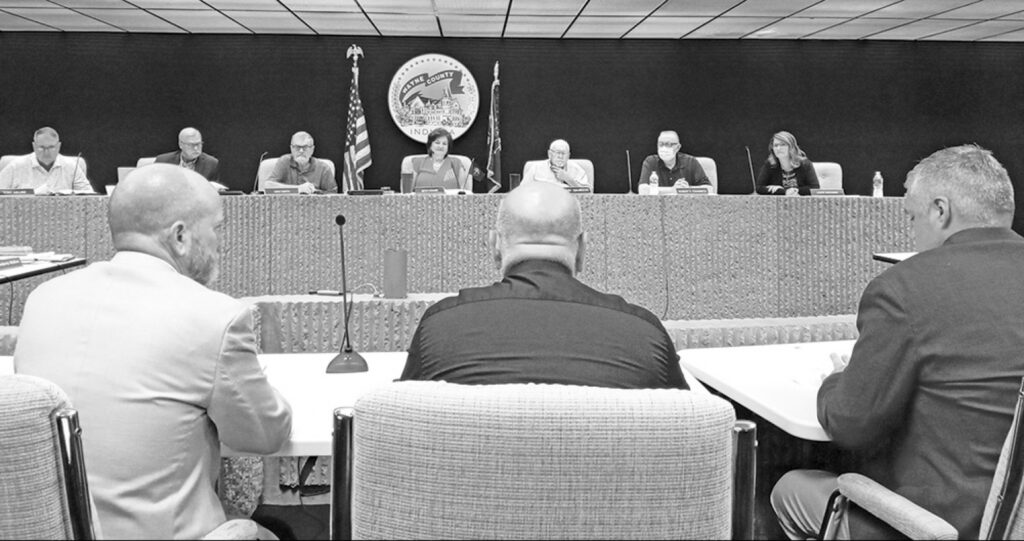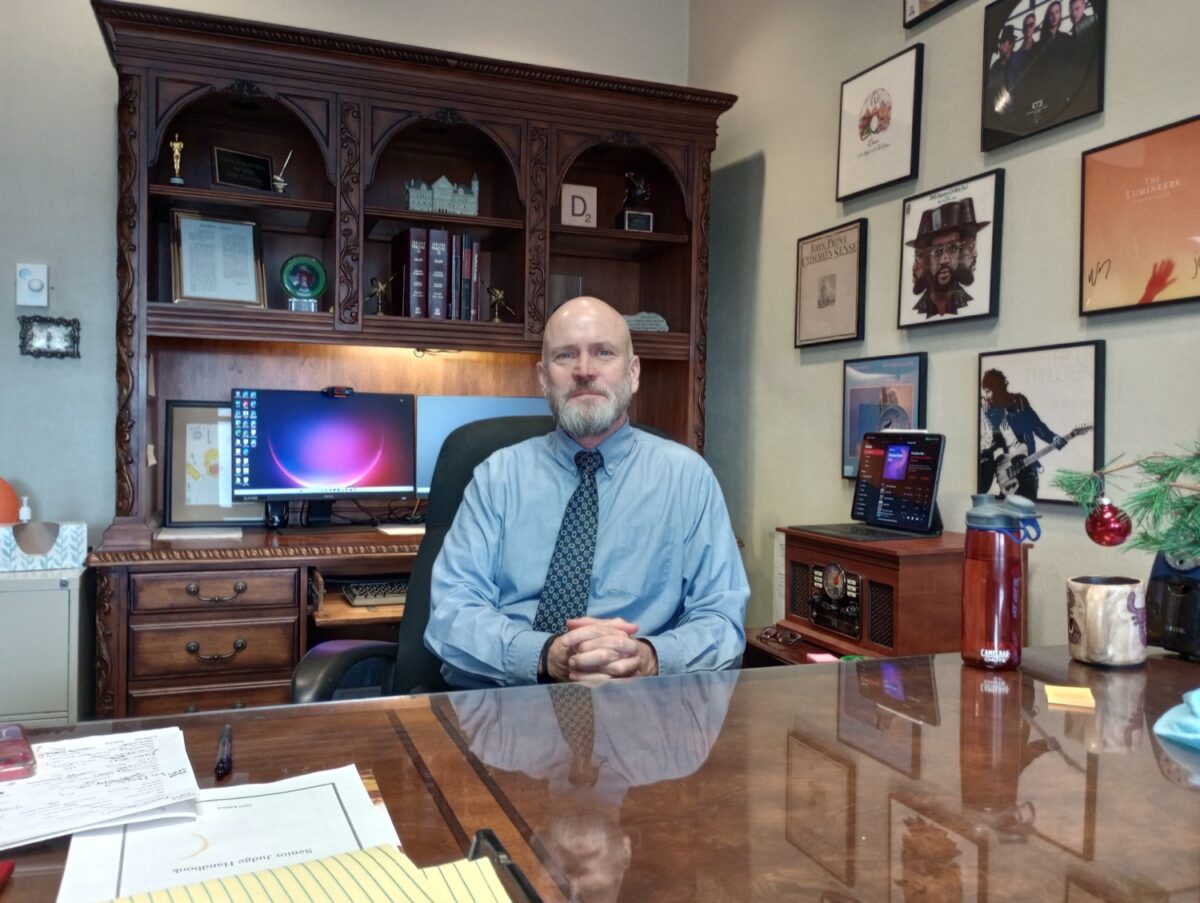When Judge Darrin Dolehanty addressed Indiana’s judges as the Indiana Judges Association’s president, he always began the same way: “This is the best gig in the world.”
Dolehanty took the Wayne County Superior Court 3 bench Jan. 1, 2003, and after more than two decades, he’s giving up his spot on the bench — mostly. Dolehanty will retire Jan. 31 from Superior 3; however, he’ll serve as a senior judge and continue with a myriad of state-level boards and committees. In fact, Dolehanty’s first day of retirement includes attending a committee meeting.
While he’s in Indianapolis, Mark Cox will begin presiding over Superior 3. Gov. Eric Holcomb on Jan. 3 appointed Cox, who has practiced in Wayne County and handles public defender cases in Wayne, Henry, Randolph and Fayette counties.
Being a judge, Dolehanty said, is demanding and rewarding. Judges resolve disputes and make decisions every day that impact people.
“I’ve enjoyed it tremendously,” Dolehanty said. “The importance of it, I think, can be lost on people that aren’t in contact with the system much, but the importance of the rule of law can’t be overstated. It’s what keeps our civilization intact, and judges are obviously a huge part of preserving that rule of law.”
When Dolehanty won the 2002 election, he did not plan on presiding 21 years in Superior 3, which has a specialized docket different from the other three county courts. He figured he might switch courts when one of the other judges retired. It didn’t work out that way.
Superior 3 handles traffic infractions, small claims, all misdemeanors, low-level felonies and all juvenile cases. Dolehanty found he especially enjoyed working with juveniles.
“One of the priorities for me as a new judge was to learn everything possible about the juvenile law,” Dolehanty said. “Once you dig into it, it’s a really interesting niche market. Not many judges handle juvenile law cases.”
Dolehanty called juvenile courts the original problem-solving courts, with Indiana following Illinois as the second state implementing juvenile courts.
“(I) learned as much as I could and really developed an affinity for the juvenile law,” Dolehanty said, “so staying here has allowed me to keep that part of the docket.”
Court changes
Dolehanty also helped usher change in the county’s juvenile system. The county was accepted into the state’s Juvenile Detention Alternatives Initiative beginning in 2014, trying to find alternatives that reduce the number of young people placed in secure detention. In the four years prior to joining JDAI, Wayne County placed 67 juveniles with the Indiana Department of Correction at a cost of $1,353,272. Dolehanty said the county now generally has just one juvenile in secure detention.
The JDAI program changes the way law enforcement, the courts and the probation department approach juvenile cases, with a focus on understanding the differences between juveniles and adults. Through the probation department, the county has invested grant resources in training programs such as teaching the teen brain, parenting the teen brain and policing the teen brain.
“We know, to the extent you know anything from statistics and science, that a kid who is placed in detention is tremendously more likely to reoffend as an adult than a kid who is not, so what do you do instead?” Dolehanty said. “Because the community is not going to tolerate and it wouldn’t make great sense to do nothing, so the answer is how do you modify your response. Instead of just locking the child up, what can you do instead, so that’s where you develop alternatives — the A in JDAI — that work for your community.
“It’s been very beneficial to us. That’s been one of the biggest institutional changes for Superior Court 3.”

Another change is an intervention program for first-time driving while intoxicated offenders. The county partners with Centerstone and sends the offenders to a counseling program. If they complete the counseling, they avoid jail time.
“We’re seeing this huge number of repeat (DWI) offender felonies,” Dolehanty said. “Well, OK, judge, what are you going to do about that? So a group of us sat down and brainstormed our way through it to see if maybe this program would knock the number of repeat offenders down. It has done so. Most of the people who enter the program succeed in getting through it without having to go back to jail.”
He thinks that program, like JDAI, has benefited the community and hopes the community agrees.
Adaptations that reduce recidivism certainly are important, but Dolehanty said his highlights come from interactions with people who have appeared before him. Judges sometimes have positive impacts on people, and Dolehanty appreciates later interactions with people who tell him about their current lives.
“The reason they come back is because they want to show you, I’m not a bad person, and whatever we did gave them the opportunity to take a different trajectory than it looked like they were trying to sign up for originally,” Dolehanty said.
Superior 3 beginning
Dolehanty’s first exposure to Superior 3 came a decade before he assumed the bench. As a young lawyer with Reller, Mendenhall, Kleinknecht & Milligan, Dolehanty was offered a part-time job by Prosecutor Terry O’Maley, with whom Dolehanty played lunchtime basketball at the downtown YMCA.
“I really found I enjoyed the criminal work quite a bit,” Dolehanty said.
When a full-time deputy prosecutor’s position opened, Dolehanty jumped to the prosecutor’s office.
“That’s kind of the leap-of-faith approach to take, because that was a great firm with seriously top-notch attorneys,” Dolehanty said. “You couldn’t find a better place as a fledgling attorney to start, so that was a tough decision.”
One that clearly worked out well.
Dolehanty became chief deputy prosecutor when David Kolger, who himself would become Circuit Court judge, took over as prosecutor. Kolger, whom Dolehanty called “an exceptional trial attorney,” taught his chief deputy much, serving as “a big help to my career,” Dolehanty said.
With that experience, Dolehanty decided to pursue the Superior 3 bench during the 2002 election, unseating the sitting judge, Bill Hoelscher, in the Republican primary and running unopposed in the general election. Dolehanty joined Circuit Court Judge Douglas VanMiddlesworth, Superior 1 Judge Tom Snow and Superior 2 Judge Bob Reinke, three judges who helped interest Dolehanty in becoming a judge.
“When you see the Bob Reinkes and the Tom Snows of the world and the way that they handle their courts, you can’t help but admire them and aspire to maybe do that job yourself one day,” Dolehanty said. “That was a big part of it.”
Continuing service
Even while stepping away, Dolehanty will continue doing that job. Acting as a senior judge — a former judge who substitutes for an absent judge — keeps Dolehanty doing “the things I like doing about this job”. He’ll also experience different types of cases than Superior 3’s regular docket, something that already occurs when he serves as a special judge in Wayne or other counties.
Dolehanty will also continue impacting the profession through state-level professional groups. He’s involved with the Youth Justice Oversight Committee, Judges and Lawyers Assistance Program, Indiana Supreme Court’s Commission on Equity and Access, Judicial Education Committee, Indiana Criminal Justice Institute, Indiana Council of Juvenile and Family Court Judges and the Judges Association.
The assistance program helps judges and lawyers battling mental health or substance abuse problems to find the right path, hopefully without losing their occupations and families. Princess Darnell, an Earlham College graduate, is the No. 2 diversity officer in the state’s judicial branch, and Dolehanty said there’s more work necessary with Darnell to improve the profession’s equity and access.
The Judges Association includes almost every judge in Indiana and works with the other governmental branches. Dolehanty’s two years as president ended last year, but he plans to still represent the judiciary during the General Assembly’s short 2024 session.
“When session kicks up here in January, my plan is to be at the statehouse as much this year as I have been the past two years, going to the committee meetings, testifying on bills,” Dolehanty said. “It’s a lot of fun. It’s a very active and very dynamic process the General Assembly goes through.”
Dolehanty said he’s enjoyed the state-level work, accepting offers whenever he can make the time commitment work.
“It’ll be good for me to stay involved with those groups,” he said. “Like a lot of businesses, including the business of the judiciary, a tremendous amount of work is done, not in the courtroom, but off committee work like these committees, as well.”
There won’t just be judicial work, however. He and his wife, Cherie, will travel and connect with family spread throughout the state and the country.
“My wife and I, we have a good time together,” Dolehanty said. “We enjoy each other’s company a lot, love to travel together.”
Dolehanty didn’t become a judge because of just one factor, and he’s not retiring now because of any single reason. He said it’s important to know when you should step away and take advantage of other opportunities.
With his exit, though, Dolehanty said he’s jealous of Cox’s opportunity. The new judge can start over and handle the court however he wants. Dolehanty hopes some of his ideas remain, but said that’s selfish because he hopes he handled the court correctly, efficiently and effectively for the community.
“That’s the beauty of passing the torch on to somebody else,” Dolehanty said. “You sit back and see what they’re doing and think, ‘Ah, that’s brilliant. Why didn’t I come up with that? I should have done that myself.’”
A version of this article appeared in the January 10 2024 print edition of the Western Wayne News.

